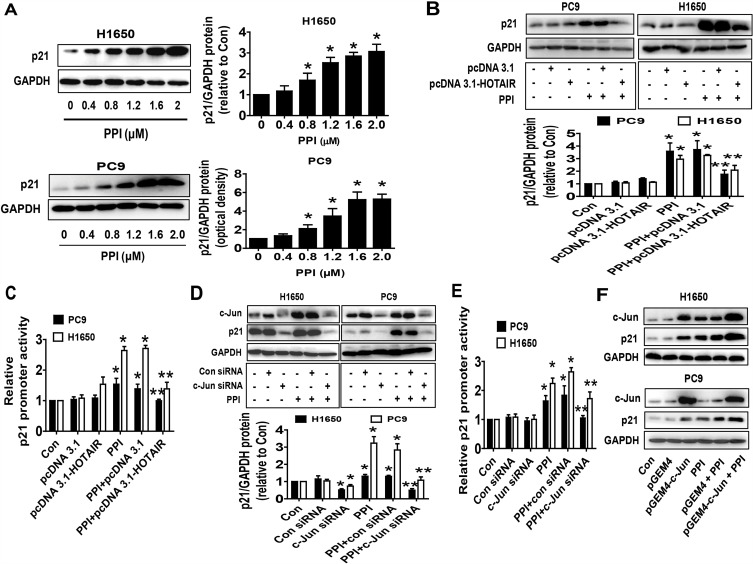Figure 3.
PPI increased expression and promoter activity of p21, which were overcome by excessive expression of HOTAIR and silencing of c-Jun. (A) PC9 and H1650 cells were treated with different concentrations of PPI for 24 h. The expression of p21 protein was detected by western blot. GAPDH was used as a loading control. (B, C) PC9 and H1650 cells were transfected with the control or HOTAIR expression vectors for 24 h, or a wild-type human p21 promoter reporter construct ligated to luciferase reporter gene (GV238-CDKN1A) and the internal control for 24 h, followed by treating with PPI (1.6 μM) for an additional 24 h. Afterward, the p21 protein levels and promoter activities were determined by western blot (B) and the Dual-Luciferase Reporter Assay System (C) as described in the Materials and Methods section. (D, E) PC9 and H1650 cells were transfected with the control or c-Jun siRNAs for 24 h, or a wild-type human p21 promoter reporter construct ligated to the luciferase reporter gene and the internal control for 24 h, followed by treating with PPI (1.6 μM) for an additional 24 h. Afterward, the c-Jun and p21 protein levels and p21 promoter activities were determined by western blot and the Dual-Luciferase Reporter Assay System as described in the Materials and Methods section. GAPDH was used as a loading control. (F) PC9 and H1650 cells were transfected with the control or c-Jun expression vector, followed by treating with PPI (1.6 μM) for an additional 24 h. Afterward, the c-Jun and p21 protein levels were determined by western blot. GAPDH was used as a loading control. The figures are representative cropped gels/blots that have been run under the same experimental conditions. Values in bar graphs were given as the mean±SD from three independent experiments. *Indicates significant difference as compared to the untreated control group (P<0.05). **Indicates significant difference from PPI treated alone (P<0.05).

